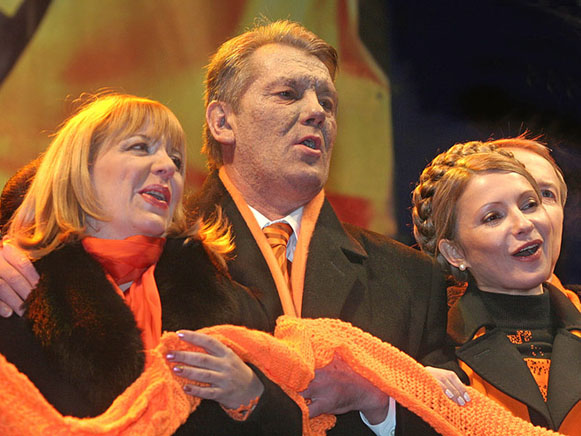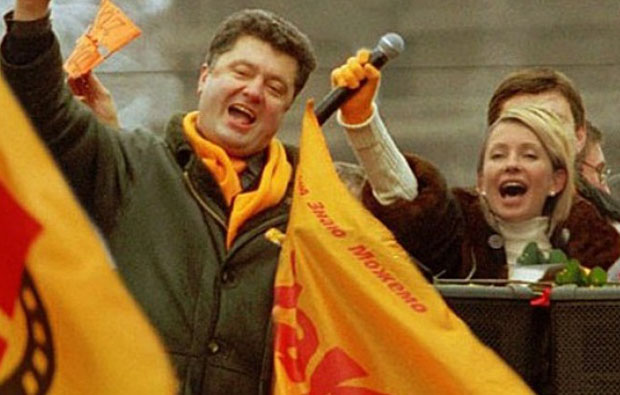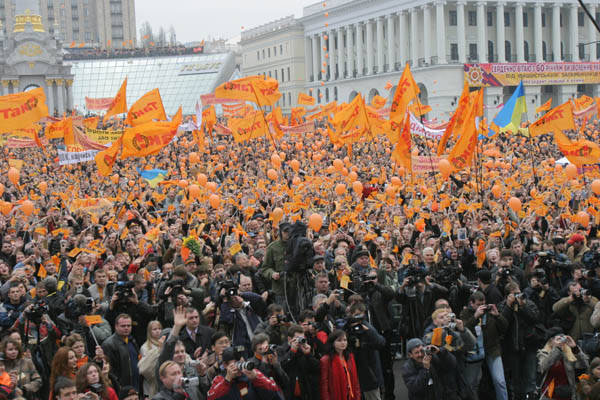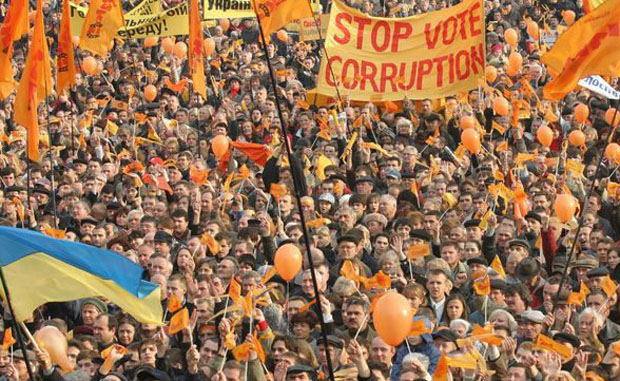Orange Revolution
Orange Revolution [Помаранчева революція; Pomarancheva revoliutsiia]. The term Orange Revolution refers to the extraordinary events associated with the presidential elections of 2004 in Ukraine, ultimately won by Viktor Yushchenko over the establishment candidate, Viktor Yanukovych. Yushchenko’s campaign colors gave the revolution its name. Although not a true revolution in the proper sense—wholesale replacement of the regime, its political elite, and dominant idea—it nevertheless is considered a landmark revolutionary event in the political history of Ukraine.
An unprecedentedly large-scale public revolt against the authoritarian rule of President Leonid Kuchma, the Orange Revolution’s origins could be traced to the 2000 Heorhii Gongadze scandal, dubbed Kuchmagate. It gained momentum with the ‘Ukraine Without Kuchma’ movement that had managed to stage protest rallies with as many as 50,000 participants. Opposition coalesced around Kuchma’s ex-prime minister Viktor Yushchenko whose political party Our Ukraine (Nasha Ukraina) led with 24 per cent of the PR vote in the Supreme Council of Ukraine elections of 2002. More protests followed, but their effective suppression produced ever-diminishing popular mobilization. In April 2003, Kuchma identified Viktor Yanukovych, the then prime minister, as his potential successor, and introduced a constitutional ‘reform’ that would have seriously curtailed the powers of a future president. Surprisingly, the measure failed to pass in the Supreme Council of Ukraine (294 votes instead of the required 300), an unexpected win for the opposition. Thus the 2004 presidential election became a contest between the authorities and the opposition concerning the balance of power, and entailing the use of ‘administrative resources’ versus popular protest.
Viktor Yushchenko’s campaign strategy consequently emphasized his being the people’s—as opposed to the government’s—candidate, counting on mass mobilization of support through organized public rallies, especially in Kyiv. His message: truth, freedom, and rights, in place of corruption, authoritarianism, and criminality. Viktor Yanukovych relied principally on an increase in pensions made on the eve of the election to carry him through. Funding for the pension increase was provided by the Russian Federation along with a panel of ‘political technologists,’ notorious image-makers and propagandists, who planned and directed the campaign of Yanukovych. The Russian-backed establishment candidate’s campaign included engineering a near-monopoly of television coverage in favor of Yanukovych at the expense of Yushchenko and propagating a false image of the latter as a Western Ukrainian (Yushchenko is actually from Sumy oblast in north-central Ukraine) Nazi sympathizer and NATO-American stooge.
After a secret dinner meeting on 5 September 2004 with the heads of the Security Service of Ukraine (SBU), Viktor Yushchenko fell seriously ill and had to be evacuated to a special clinic in Austria for treatment. The dioxin poisoning left him permanently disfigured, the new face of Ukraine, as he then put it to his supporters. Government-sponsored media attributed the illness to overindulgence or a self-inflicted malady. Various theories purported to explain the poisoning, but the Yushchenko team blamed the regime, meanwhile Yushchenko’s dinner host fled to Moscow from where he could not be extradited. Whether the tête-à-tête with the SBU yielded for Yushchenko the anticipated result—non-interference by the agency in the planned Orange tide of protest against anticipated falsification of the vote or even tacit support, the meeting’s purported purpose—is uncertain.
After the ballots had been cast on Sunday, 31 October, it took the Central Electoral Commission (CEC) until the evening of 10 November, the maximum gestation period allowed by law, to announce the official results. The two front-runners were: Viktor Yushchenko, 39.87 per cent; Viktor Yanukovych 39.32. They then were set to confront each other in the second round, on 21 November. Anticipating fraud in favor of his adversary, Yushchenko asked his supporters to assemble in Independence Square (Maidan Nezalezhnosti) after the polls had closed on Sunday evening, 21 November, in protest. The likelihood of fraud was already testified by the hundreds of complaints filed that day with the CEC, as well as indirectly involving the CEC itself with its hourly reports of voter turnout which vaulted inexplicably from the 70 per cent level in the last hour of voting into the 80s and 90s in certain oblasts. In fact, a secret rogue server was intercepting the results sent in from the electoral districts, massaging them, and passing this on with instructions to the CEC to issue the falsified figures. The so-called transit server was under the control of the ‘political technologists’ from the Russian Federation in support of the Yanukovych campaign to guarantee his victory. Contrary to his own instructions, Yushchenko’s supporters did not disperse for the night. Instead, tens of thousands and soon hundreds of thousands assembled and stayed in the Maidan. Thus began the Orange Revolution.
According to some, an estimated maximum of one million demonstrators were in attendance. Viktor Yanukovych’s counter-demonstrators, numbering between 5,000 and 15,000, congregated in front of the Kyiv railway station, where they had been brought by train from the east. The Orange protest was well-organized so that tents, food, sleeping bags, and medical care were provided; no alcohol or weapons were allowed. Businessman Petro Poroshenko used his resources to assist with equipment, particularly tents of which there were 2,000 at the height of the revolution. The protesters policed themselves. The mayor of Kyiv allowed them to use space in City Hall for their needs. A giant stage supplied entertainment and encouragement, with speeches, music, announcements, as well as greetings and endorsements from the representatives of sympathetic entities; it was more of a festival than an angry mob of revolutionaries—a manifestation of Gandhiian non-violent resistance. This combination of festivity and order was not fortuitous, but the behind-the-scenes work of an activist youth organization, Pora, and its 20,000-odd members drawn into the Yushchenko campaign in the summer of 2004. Modelled on Otpor (‘Resistance’) in Serbia and Kmara! (‘Enough!’) in Georgia, Pora consisted of two wings: the leaderless and amorphous Black Pora and the more entrepreneurial Yellow Pora. Taking their tactics of humor, mockery, and carnivalesque street demonstrations from the previous ‘color revolutions’ they applied them to the Maidan. Yushchenko shared the stage with Yuliia Tymoshenko who gave voice to the revolution’s more radical sentiments—‘Bandits to jail’ was a memorable slogan. For the time being the two were a team: he the pragmatic moderate, she the radical populist. Her decision at the outset not to contest the presidency but to support him was a major factor in Viktor Yushchenko’s eventual success. The size of the demonstration, its endurance, and the arrival of international media inhibited the authorities’ inclination to disperse it by force using the militia; the armed forces declined absolutely to intervene.
Exit polls made public on Monday, 22 November, showing Yushchenko with an 11 percentage point lead, buoyed the Orange cause and correspondingly created consternation in the Yanukovych camp. On Tuesday, 23 November, Yushchenko made a symbolic gesture of reading the inauguration oath in the Supreme Council of Ukraine. The following day, the CEC announced the official result, but only 11 of its 15 members had signed the protocol: Viktor Yanukovych, 49.5 per cent; Viktor Yushchenko, 46.6. Responding to this announcement, Yushchenko addressed the 300,000 citizens assembled in the Maidan and overflowing onto adjacent streets. He declared the creation of a committee for defense of the constitution, condemned the authorities’ disregard for the free expression of the popular will, and called for dialogue and a general strike. Notably he did not urge overthrow of the regime. He then met with representatives of foreign states and international organizations urging them not to recognize the official results of the presidential election. The President of the Russian Federation, Vladimir Putin, twice congratulated Yanukovych on his election victory even before the results had been announced by the CEC.
On Thursday, 24 November, demonstrators blockaded nearby government buildings making them inaccessible to the country’s public servants thus interfering with normal government operations. On Friday, 25 November, another CEC member revoked his signature, the Supreme Court of Ukraine agreed to review Yushchenko’s complaints thereby precluding official publication of the results in the government gazette finalizing those results legally, and international mediators arrived to assist in a resolution of the stand-off.
At the initiative of Polish President Alexander Kwaśniewski, an official European Union mission began a series of round tables bringing the contestants and President Leonid Kuchma together to negotiate a path out of the deadlock. Meanwhile, under speaker Volodymyr Lytvyn, the Supreme Council of Ukraine passed a series of resolutions condemning the conduct of the elections and the CEC, demanding a meeting with Kuchma, setting up a Committee of National Salvation headed by Viktor Yushchenko, and removing Viktor Yanukovych as prime minister. On Friday, 3 December, the Supreme Court of Ukraine acknowledged the validity of Yushchenko’s complaints stating that the violations committed made determining the true results impossible, and setting 26 December as the date for a repeat second round of the presidential election. The decision was not open to appeal. On 7 December, Kuchma signed the decree dismissing Yanukovych as prime minister and appointing Mykola Azarov as his replacement. The next day, the Supreme Council of Ukraine voted to dismiss the CEC and passed by 402 votes a packet of laws incorporating the negotiated agreement. This included constitutional changes (bill 4108) strengthening parliament at the president’s expense, to take effect no later than 1 January 2006, and closely modeled on Kuchma’s reform proposal of April. Under this bill, most ministers would be approved by the Supreme Council of Ukraine, which could also dismiss them individually or collectively. The prime minister and cabinet would be responsible to the parliamentary majority rather than solely to the president. Unsurprisingly, the settlement was a compromise; such was the extent of the Orange Revolution’s achievement.
Subsequent events provided plentiful material for debate as to the Orange Revolution’s nature, consequences, and significance. Some prominent figures associated with the Leonid Kuchma regime immediately fled abroad; a few committed suicide; the Russian ‘political technologists’ and others retreated to Moscow. Initially, the upheaval was characterized by observers as a democratic breakthrough, but this became doubtful as time went on. Its moment of glory was short-lived, as the would-be revolutionaries settled into their customary infighting neglecting their own agenda of institutional change. That agenda included action on anticorruption, reprivatization of state assets acquired at below market valuation, judicial reform, and implementation of the rule of law. Yuliia Tymoshenko was named prime minister; a disappointed Petro Poroshenko became head of the National Security and Defense Council (RNBOU), where he set up a parallel government in competition with her. Neither lasted long in their positions (Tymoshenko sacked in September 2005), and Viktor Yanukovych returned as prime minister in 2006 when support shifted towards him in the Supreme Council of Ukraine. In 2010, Yanukovych attained what had eluded him in 2004 by defeating Tymoshenko for the presidency, 49.0 per cent of the vote in the second round to 45.5. She could not count even on Viktor Yushchenko’s support, however marginal, as he urged citizens to vote against both. Also in 2010, the constitutional reform of 2004 was rescinded on grounds of its own unconstitutionality—it had been approved in a single session, rather than two successive ones. Thus was undone the Orange Revolution’s major accomplishment in the constitutional realm, only to be restored again in the wake of the Euromaidan Revolution in 2014, a revolt against Yanukovych’s presidency. In the context of post-communist politics, the Orange Revolution certainly counts as revolutionary in spirit by awakening Ukrainian civil society and setting a precedent for the Euromaidan Revolution in 2014 even if not in immediately consequential execution.
BIBLIOGRAPHY
Kamrava, M. ‘Revolution Revisited: The Structuralist-Voluntarist Debate,’ Canadian Journal of Political Science, 32, no. 2 (June 1999)
Kul'chyts'kyi, S. Ukrains'ka revoliutsiia 2004 (Kyiv 2005)
Ianevs'kyi, D. Khronika ‘Pomaranchevoi’ revoliutsii (Kharkiv 2005)
Kuzio, T. ‘From Kuchma to Yushchenko: Ukraine’s 2004 Presidential Elections and the Orange Revolution,’ Problems of Post-Communism, 52, no. 2 (March/April 2005)
Kuzio, T. ‘Ukraine’s Orange Revolution: The Opposition’s Road to Success,’ Journal of Democracy, 16, no. 2 (April 2005)
D’Anieri, P. ‘What Has Changed in Ukrainian Politics? Assessing the Implications of the Orange Revolution,’ Problems of Post-Communism, 52, no. 5 (September/October 2005)
Wilson, A. Ukraine’s Orange Revolution (New Haven and London 2005)
Wilson, A. Virtual Politics: Faking Democracy in the Post-Soviet World (New Haven 2005)
Åslund, A.; McFaul, M. (eds). Revolution in Orange: The Origins of Ukraine’s Democratic Breakthrough (Washington DC 2006)
Wilson, A. ‘Ukraine’s Orange Revolution, NGOs and the Role of the West,’ Cambridge Review of International Affairs, 19, no. 1 (March 2006)
Kuzio, T. ‘Oligarchs, Tapes and Oranges: ‘Kuchmagate’ to the Orange Revolution,’ Journal of Communist Studies and Transition Politics, 23, no. 1 (March 2007)
McFaul, M. ‘Ukraine Imports Democracy: External Influences on the Orange Revolution,’ International Security, 32, no. 2 (Fall 2007)
D’Anieri, P.; Kuzio, T. (eds). Aspects of the Orange Revolution I: Democratization and Elections in Post-Communist Ukraine (Stuttgart 2007)
Kuchma, L. Posle Maidana (Kyiv 2007)
Harasymiw, B.; Ilnytzkyj, O. (eds). Aspects of the Orange Revolution II: Information and Manipulation Strategies in the 2004 Ukrainian Presidential Elections (Stuttgart 2007)
Besters-Dilger, J. (ed). Ukraine on its Way to Europe: Interim Results of the Orange Revolution (Frankfurt-am-Main 2009)
D’Anieri, P. (ed). Orange Revolution and Aftermath: Mobilization, Apathy, and the State in Ukraine (Washington, DC and Baltimore 2010)
DeFronzo, J. Revolutions and Revolutionary Movements, 4th edn (Boulder, Colorado 2011)
Haran, O. ‘From Viktor to Viktor: Democracy and Authoritarianism in Ukraine,’ Demokratizatsiya, 19, no. 2 (Spring 2011)
Haran, O. ‘Ukraine: Pluralism by Default, Revolution, Thermidor,’ Russian Politics and Law, 50, no. 4 (July-August 2012)
Shekhovtsov, A. ‘The ‘Orange Revolution’ and the ‘Sacred’ Birth of a Civic-Republican Ukrainian Nation,’ Nationalities Papers, 41, no. 5 (2013)
Beissinger, M. ‘The Semblance of Democratic Revolution: Coalitions in Ukraine’s Orange Revolution,’ American Political Science Review, 107, no. 3 (August 2013)
Kudelia, S. ‘The Maidan and Beyond: The House that Yanukovych Built,’ Journal of Democracy, 25, no. 3 (July 2014)
Fainer, M. Pomarancheva Revoliutsiia: Dzherela, rushiini syly, uroky, perspektyvy, 2d edn (Chernivtsi 2015)
Bohdan Harasymiw
[This article was written in 2020.]

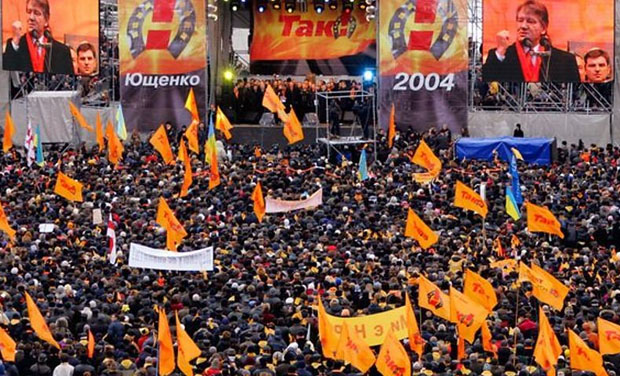
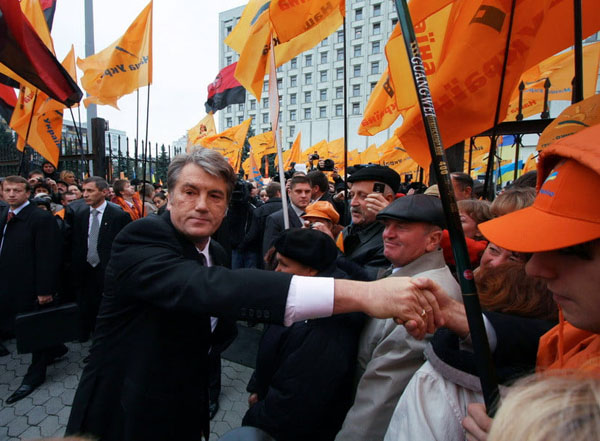
.jpg)
